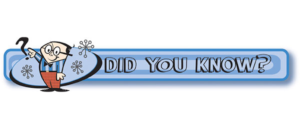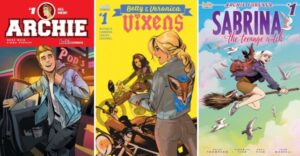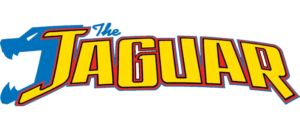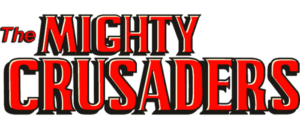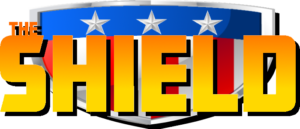THE MLJ STORY

Comics Collector, Winter 1984
By Ron Goulart
Earlier this year, the Archie Comics folks again resurrected some of their old-time superheroes and costumed crime fighters. By way of their Red Circle line of comic books you can once again follow the adventures of Steel Sterling, The Shield, The Black Hood, Mr. Justice, and several other heroic chaps who first set up shop 40 and more years ago. I got a kick out of seeing some of my boyhood idols cavorting again and I wish Red Circle well.
The only trouble is, for someone like me who grew up following these fellows in their original Golden Age incarnations, these latter-day Mighty Crusaders are too slick and sensible. I miss those old illogical, sometimes outright wacky, heroes of my youth. I miss, too, the second-banana good guys – such as Mr. Satan, Ty-Gor, The Firefly, Captain Valor, etc. – who probably won’t even get revived this time around. And I miss the eclectic look of the magazines of that long ago and more innocent age.
Let me, in the following pages, show you what I mean.
When these particular heroes first came forth, Archie hadn’t even been born and the publishers called themselves MLJ Magazines, Inc. Less formal than MGM, the company took its title from the first name initials of its proprietors. They were Morris Coyne, Louis Silberkleit and John Goldwater and they entered the fast-growing funny book field late in 1939. The artwork and scripts for the earliest issues of the new titles were provided by the sweatshop run by Harry “A” Chesler. While some gifted people worked for the enterprising Chester, it doesn’t look as though he sent in his first team to produce material for Morris, Louis, and John.
The MLJ line got off to a rather shaky start with the launching of Blue Ribbon Comics. The first issue had a November cover date and its star was not a superhero but a dog. Rang-A-Tang, billed as The Wonder Dog, was right there on the cover acting courageous and his six-page adventure started off the issue. Rin Tin Tin, who’d made his movie debut way back in the silent days of 1916, was undoubtedly the inspiration for this less-than-scintillating feature. Most of the other strips, such as Dan Hastings, Buck Stacey and Burk of the Briney, weren’t much snappier. Science-fiction hero Hastings wasn’t even brand new, having already done his stuff in Star Comics as early as two years before.
About the only bright spot in the issue was Crime on the Run, a lively, Gang Busters sort of feature turned out by a young fellow named Jack Cole, later famed for creating Plastic Man. Although he favored big-foot gag cartooning, Cole was already developing an effective adventure style. He also, unlike most of the Chester colleagues he shared the magazine with, understood that comic books were different from newspaper strips and pulp magazines. Cole’s page layouts and his staging of scenes take advantage of the format.
Blue Ribbon’s first superhero arrived in the second issue. He wore a green costume, green cowl with wings over the ears, and a scarlet cape. His name was Bob Phantom. That doesn’t seem to be too striking a name for a chap who fancies himself “the Scourge of the Underworld.” A crime buster with a first name is just too folksy to be formidable. You probably wouldn’t be frightened by Bill Batman or Fred Superman either. Actually, Bob seems to have come by his name because the Chester shop had it left over from an earlier character. Another Bob Phantom, a mustached magician in this case, had appeared way back in the first issue of the aforementioned Star Comics (February 1937) and then vanished. This new Bob P., drawn by Irving Novick, stuck around for two issues and then defected to Top Notch Comics.
Charles Biro, like Cole an artist/writer who’d leave his mark on comics (he later created Crime buster, Airboy, and the original Daredevil), also showed up in that second issue. His Scoop Cody, dealing with an ace reporter, expired after two go-rounds, but Corporal Collins, about a “two-fisted American in the French infantry,” fared somewhat better. In fact, for a short time the redheaded Jimmy Cagney-type soldier was the star of the faltering magazine.
The third issue was much the same as the two preceding. But the fourth, which didn’t hit the stands until five long months later (cover-dated June 1940), was a great leap forward. Coming to their senses just in time, MLJ had dumped Chesler and hired some of his better people away from him.
“Thrill to these smashing NEW features,” proclaimed ads in the other MLJ titles (there were three more by now Top Notch, Pep and Zip). Gone were Scoop Cody, Buck Stacey, Dan Hastings, and their ilk, replaced by Hercules, The Fox, The Green Falcon, Ty-Gor, and Doc Strong. Showcased on the cover of #4 was the feisty Corporal Collins, blazing away with a machine-gun pistol in one hand and tossing a grenade with the other. In the midst of all this excitement you could almost overlook the fact that Blue Ribbon still didn’t have a first-rate superhero on the staff.
The closest thing was Hercules, written by Joe Blair and drawn by Elmer Wexler. For this one, Blair went all the way back to Greek mythology. “Hercules, strongest man in all history, earned a place on Mt. Olympus by wiping out the evils of ancient Greece. Now Zeus has ordered him back to Earth to rid the modern world of wars, gangsters and racketeers!!” The gimmick here, somewhat highbrow for a lowly comic book, was that Herc would tackle modern equivalents of the original 12 Labors of Hercules. Unfortunately, he only got as far as the fifth before he was dropped from the line-up.
The Fox was a costumed crime fighter, but he didn’t have a super power to his name. In everyday life, he is Paul Patton, “former all-around athlete at Penn State,” who is now working as a newspaper photographer. Written by the ubiquitous Blair, the strip was drawn initially by Irwin Hasen. Younger readers, who are familiar only with Hasen’s newspaper strip Dortdi, may find it hard to believe he once turned out effective comic-book adventure stuff. He did, though, and The Fox benefited from his loose, quirky style. Like Cole, Hasen thought in terms of the comic book page and his layouts explored possibilities overlooked by some of his stodgier contemporaries. His only problem was with The Fox’s jet-black costume. It took Hasen a couple of issues to realize a hero’s costume is a fantasy thing that doesn’t have wrinkles or baggy knees.
Despite his name, The Green Falcon was not a super guy but a green-clad knight who hung out in the days of Richard the Lion Hearted and behaved in the Robin Hood manner. Doc Strong was a science-fiction feature and Doc himself was a famous scientist who went around stripped to the waist and wearing the trousers from one of his old business suits. It was set one hundred years in the future when “more than half the world has been wiped out, and cities lie in crumbling ruins and then a new menace arises, a vast barbaric horde from some forgotten corner of Asia descends on a trembling world.”
The comic books of The Golden Age provided work for unemployed artists from other areas, including newspaper strips. Ty-Gor, about an orphaned lad raised by tigers in the Malay jungles, was drawn by one such. George Storm had done a successful strip, Bobby Thatcher, until 1937 and then retired to try his hand at being a gentleman farmer in Oklahoma. By 1939 he was ready to get back into cartooning and he returned to New York. We’ll have more to say about him when we get to his better-known MLJ creation, The Hangman.
Finally, in issue #9 (February 1941), Blue Ribbon Comics signed on somebody who could pass as a superhero. His only flaw was that, like The Spectre over at DC, he was dead. Mr. Justice, created by the busy Joe Blair and artist Sam Cooper, was actually the spirit of Prince James, heir to the throne of England and murdered “exactly 200 years ago . . . but the legend has it his spirit arose from his body and strangled the men who murdered him.” Cooper’s notions of what life in 18th Century England was like are quite interesting and he draws the prince and his murderers wearing armor and chain mail. At any rate, the historic castle where the deed was done is, in 1941, “torn down and carted away, stone by stone . . . loaded aboard a ship and sent on its journey to America.” We can assume Blair got his inspiration for this part of the plot from the movie The Ghost Goes West. Enroute to America the castle-laden ship is torpedoed by a Nazi sub and this somehow liberates the spirit of Prince James. “Free! I’m free!” he exclaims as his soul soars upward from the sinking wreckage, decked out in cape and tights.
Like The Spectre, Mr. Justice has pupil-less Little-Orphan-Annie eyes when he’s in his evil-combating mode. Off-duty he assumes “the form of a mortal man” and goes around as a handsome blond fellow in a business suit.
During his relatively brief career, Mr. Justice, sometimes referred to as The Royal Wraith, combated such villains as Rialb (Blair spelled backwards), a mystic who summoned up “demoniacal monsters” to do his bidding; Zarro the Zombie Master, a green-skinned voodoo man; a crazed doctor who brought executed criminals back to life; a green fellow named Ribo who possessed “the most hideous organ of sight ever seen on Earth – THE EVIL EYE!!”
Some of Mr. Justice’s antagonists were so awesome that The Royal Wraith couldn’t quell them in a single episode and had to battle them over several issues. One such was called The Dictator. He’s quite obviously Hitler, but in those months before America entered World War II, many comic book publishers were reluctant to have him appear under his real name; although it’s unlikely the Fuhrer would have sued for defamation of character. The payoff is that The Dictator turns out to be Satan in more-or-less human form.
Hardly was this villain bested when up popped The Green Ghoul, a scaly chap with three bloodshot eyes. He’s devoted to “committing murder and atrocity as fast as his wretched mind can conceive of new plots.” Mr. Justice needed a full three months to overcome The Green Ghoul. They meet for their final showdown in “the void between the spirit world and the real world.” Out punching his rival, Justice sends him at last into the sea “to sink to the foul depths from which he sprang.”
Sam Cooper rendered all this half-baked horror in a toothsome style that never missed an opportunity to be excessive. His ghouls and demons are all appropriately loathsome, their twisted, gaping mouths jam-packed with such a spiky array of fangs that feasting on anything but human flesh would have been out of the question. He never passed up a chance to depict his fiends slavering and drooling and few could draw a dagger entering an innocent heart with such explosive bloodiness.
After Mr. J came Inferno, who made his debut in #13 (June 1941). Also known as The Flame Breather, Inferno had first turned up as a villain over in Zip Comics. Reformed by Steel Sterling, he went straight and was rewarded with a strip of his own. His only wild talent was being able to spout flame out of his mouth.
The magazine’s last hero came along three issues later and was of the super patriot persuasion. Tom Townsend was just another drunken playboy until an enormous eagle carried him off to its mountain lair. Tom’s father, “wealthy inventor of the Army’s new bomb sight,” had been kidnapped and tortured by a sinister villain known only as The Black Hand. A cadaverous fellow with dead-white skin, The Black Hand dressed in a hooded purple robe. He came by his name because of his right hand – “It is BLACK . . . diseased! A disease easily capable of being transmitted by penetrating the skin with my claws!” In order to make the stubborn senior Townsend talk, his son is abducted as he comes staggering out of the exclusive Crane Club. Unfortunately, The Black Hand loses his temper and strangles Tom’s father. He’s about to do the same thing to the young playboy, when an eagle smashes into the rundown mansion and carries Tom off in his talons.
While The Hand goes on a rampage of sabotage and ruthless crime, Tom stays in the mountains with the eagle and “develops the muscles he had allowed to degenerate.” One day, after the former wastrel has shaped up sufficiently, the eagle brings him an American flag. “This is a symbol of my destiny – a destiny I vow to fulfill!” He whips up a star-spangled costume “and so Tom Townsend becomes Captain Flag!” His first target is, of course, The Black Hand. In the battle that ensues, The Hand is knocked cold and seems to perish in the fire that sweeps his hideout. “But is The Black Hand really dead? See for yourself in the next issue!”
The Hand does come back, several times. In issue #22, Captain Flag captures him once again and thwarts a piracy scheme of his. “You’re going to hang, Black Hand,” Flag informs him. “Since you wanted to live as a pirate you shall die as one.” Sure enough, in the last frame we see The Hand, purple robe and all, dangling from a yardarm. “What adventures await Captain Flag now?” asks a caption. None is the correct answer, since this turned out to be the last issue of Blue Ribbon.
And this ends our first installment. Don’t miss next issue, when we’ll meet the man with the super-brain, a fellow who was inspired to become a hero by a luminous insect, and a super boy with the imaginative name of Roy.
The second MLJ title was Top-Notch Comics, launched a month after Blue Ribbon and with a cover date on its initial issue of December 1939. Although the magazine boasted only one superhero when it commenced, by the end of its first year Top-Notch would house a bunch of them.
As stated before, the material in the earliest issues of the MLJ titles was produced by the pioneer sweatshop run by Harry “A” Chesler. Although he’d been in operation since 1936, turning out stuff for various publishers, Chesler doesn’t seem to have made much of an effort to keep up with what was going on in the burgeoning comic-book business. The text and artwork his outfit churned out in 1939 was very much like the product of three years earlier, for the most part lowbrow humor and illustrated pulp that indicates little comprehension of the nature of the new field and no realization of how important the coming of Superman in 1938 had been.
The only true superhero cooked up for the first issue was The Wizard, also known as The Man With The Super Brain. Originally, he performed his deeds wearing black tie and tails, a cape, and a red domino mask. In that clean haven era, he was one of the few comic book mystery men who sported a moustache. The Wiz’ specialty was “plots against the government” and invasions. In civilian life he was Blane Whitney, polo-playing scion of one of America’s first families. “With his super-brain and photographic mind The Wizard is able to visualize far-away happenings. With these mental powers and his super-strength, he ferrets out plots against the U.S.” In his earliest battles, combating such foreign scourges as the Jatsonian invaders and the equally nasty Borentals, The Wizard used many amazing weapons of his own invention. These included Secret Formula F 22 X, the H2-VX-0 Ray, and his Dynamagno-Saw Ray Projector. The initial artist to depict the super-patriotic adventures of
this dapper good guy was Edd Ashe Jr.
Al Camy took over after a few issues and, in Top-Notch #7 (August 1940), designed him anew costume. It consisted of blue tunic and tights, red shorts, and cape. The red mask was retained, along with the moustache. In this episode, by the way, The Wizard teamed up with Pep Comics’ Shield to thwart the invasion plans of the Mosconians. Apparently not satisfied with wearing an outfit very much like that of DC’s Superman, The Wizard next set out to emulate DC’s Batman. In #8 he acquired a feisty young companion. A concluding caption proclaims, “The Wizard fights alone no longer! Now side by side with The Man With The Super Brain is Roy, the Super Boy, the most astounding youth in all history! Together these two fight all evil.” All these improvements ought to have assured the Wiz of a long, fruitful career as star of the magazine. A bit further along we’ll see what happened in #9.
Most of the other features offered in
Top-Notch’s premiere issue were pretty lackluster. Jack and Otto Binder turned out “Scott Rand,” about a Brick Bradford type who jaunted into the past in his time car. There was “Air Patrol,” a dull aviation strip, ” `Lucky’ Coyne,” a dull detective strip, and “The West Pointer,” a dull military strip. For magic fans there was “The Mystic,” which offered a turbaned stage magician who dabbled in detection between shows. All of these ran five or six pages, crowded eight panels onto a page, and had layouts about as visually exciting as your maiden aunt’s wallpaper. Charles Biro, a man destined to shake up the whole comic book business, contributed “Swift of the Secret Service.” At this point, he was still working in the drab Chester house style. About the only bright spot was provided by Jack Cole, who wrote and drew a true-crime feature called “Man-Hunters.” Cole, who also had a full page of gag cartoons in the issue, did the crime thing in his still developing straight style. Unlike many of his sweatshop colleagues, Cole had discovered that a comic-book page wasn’t a newspaper strip. He was already experimenting with provocative layouts and more effective ways of staging and telling his stories.
Another gifted, and still often underrated, artist joined the crew in the second issue. Mort Meskin contributed “Dick Storm,” about a clean-cut young fellow whose “fame as an adventurer has spread far and wide.” Meskin, who’d been influenced by such excellent pulp illustrators as Edd Cartier and Herbert Morton Stoops (and maybe someday we’ll do a piece explaining exactly who they were), was simply a much better artist than most of the others in those early issues. He, too, made use of inventive layouts, and the storytelling techniques he developed are better than the stories he was forced to tell.
As mentioned in the last chapter, Bob Phantom has always struck me as a splendid name for a mystery man. He became part of the Top-Notch cast in issue #3, the magazine’s second super hero. Somewhere about this time, Biro and several of his shop colleagues were wooed away from Chesler to go to work directly for MLJ. The magazines immediately began to look more like contemporary comic books and less like samplers of what was to be found in the bottom of Chesler’s trunk.
A new SF feature was added in #4. “Streak Chandler” was set on Mars and drawn by Don Lynch. “Galahad,” an Arthurian adventure by Lin Streeter, got going in #5. “The Mystic” was by this time calling himself “Kardak” and had picked up “uncanny, unexplainable powers, which are fortunately used for the suppression of evil.”
Yet another superman was added in Top-Notch #8 (September 1940). “The Firefly” was the creation of writer Harry Shorten and artist Bob Wood. His real name was Harley Hudson, and
he was one of those chaps who work hard and long to become a good guy. A trained chemist and biologist, he had already devoted years to study and training when we first met him in his laboratory in the Middle West. “At last,” he exclaimed, “I’ve discovered the
secret of the tremendous strength of insects!” The secret, which sounded quite a lot like what Charles Atlas was peddling on the back covers of many of the comic books of the day, involved the developing of “wonderful muscular coordination.” While HH was explaining all this to himself, the lights in his lab went out and some fireflies flickered in. “That’s what I’ll be,” he decided. “A firefly! Lighting up the darkness that shrouds the underworld!”
The Firefly fought crime for the next couple of years, folding his wings after #27 (May 1942). Among the sinister villains he illuminated and overcame were Dr. Dread, The Mummy (twice), a great white shark, and a killer whose victims “were torn and ripped by the claws of some huge, unspeakable monster!” When Wood abandoned the strip, the artwork chores were assumed by Warren King.
The month after The Firefly’s debut, obviously in the grip of costumed hero fever, Top-Notch introduced yet another. He was to prove to be one of MLJ’s most successful and enduring characters. No match for Archie, of course, but pretty durable.
The Black Hood was another fellow who had to work long and hard to become a costumed hero. While a uniformed cop, Kip Burland is framed by a sinister green-faced villain aptly known as The Skull. Discharged from the force in disgrace, Burland was taken for a ride by minions of the vindictive Skull. Left in the woods to die, he was found by a kindly old hermit. A self-taught scientist and philosopher, the hermit had also been wronged by The Skull and he decided to turn young Burland into a super-crime fighter – someone who would defeat The Skull and then use his “abilities against all crime and criminals!” Borland underwent months of rigid training, “both to rebuild his strength and to learn all of science and all of knowledge, in order to make himself the world’s greatest fighter against crime!” Donning the hood that gave him his name, along with yellow tunic, black shorts, and yellow tights, he went forth.
The Hood finally confronted The Skull at a fashionable society masquerade ball. The scoundrel managed to attack his female victim and used a poison pellet on her that caused her skin to shrivel and turn green until “her face is a caricature of The Skull!” The Black Hood unmasked his opponent, who’d been attending the party in drag, and turned him over to the law. But The Skull, true to master criminal tradition, kept coming back. He recurred in several issues until The Black Hood succeeded in getting him sent to the hot seat.
As The Black Hood’s career progressed he tangled with a succession of other bizarre foes: The vicious Panther Man; Mark Honey, “famed detective by day . . . ruthless murderer by night”; The Mist, “who was able to dissolve his body into a gaseous mist”; Scorpio, billed as the Astrologer of Death; the Mad Killer of the Opera, etc. A1 Camy was the original artist. Once The Hood came aboard, The Wizard was relegated to second banana status. He, his super brain, and Roy were dropped after issue #27 (May 1942).
In the non-super area Top-Notch added and subtracted characters. “Wings Johnson,” as his name implied, was an aviator. Redheaded “Fran Frazer,” drawn by Irving Novick, was a globetrotting newsperson and a champion of women’s rights. As a caption explained, she “has faced many weird adventures in foreign lands, and always she has proven that, in spite of her sex, she is a better man than any of her male rivals.” Fran held on for 17 issues. For sports fans, there was the St. Louis Kid, a heavyweight boxer whose path to the crown was strewn with pitfalls. On one occasion, for instance, he was forced to go several rounds with a gorilla. Lin Streeter began the feature, newspaper veteran George Storm followed, and the Archie-creator Bob Montana went a few rounds.
In the summer of 1943, anticipating a trend that would sweep through comic books a few years later at the end of the Second World War, the magazine converted to humor. With the bold slogan, “We Dare To Do It! A Joke Book That’s Really Funny!” issue #28 (July 1942) appeared under the new title Top-Notch LAUGH. Only The Black Hood and Kardak didn’t get pink slips; all the other heroes were let go. In their places you found funny stuff. The new star of the magazine was a Li’l Abner simulacrum with the tasteful name of Pokey Oakey. This was the creation of Don Dean, longtime ghost on the Big Chief Wahoo newspaper strip, and the first episodes looked as though they might be recycled samples of an unsold strip of his own.
Dean, a pretty good artist it’ not a subtle humorist, also contributed -Senor Siesta.” The senor was a diminutive Mexican fruit peddler who talked like a Mel Blanc Latin and got into humorous misadventures with bandits, politicians, and long-legged senoritas. Bob Montana was responsible for “Percy,” another teen-age epic. Top-Notch’s resident dumb, sexy blonde was a lady known as “Suzie.” Eventually the magazine added “Gloomy Gus,” about a homeless ghost, “Stupidman and the 3 Monkey-Teens,” which defies description, and “Dotty & Ditto.” This last starred a little blonde cowgirl, her parrot, and her little Indian boyfriend. Bill Woggon, the Katy Keene man, was in charge and seemed to have a good deal of fun.
With issue #30 (November 1942) The Black Hood became the only straight character in the book. He probably felt like a clergyman stranded in a boarding house full of carnival performers, but he stuck to his guns until #44 (February 1944). After one more issue the magazine became just plain Laugh Comics. A sturdy fellow, The Hood survived for another two years in his own quarterly. In his final days, drawn by Novick, he shed his costume to work in civvies as a hard-boiled private eye.
Once again we’ve used up our space. Be sure to tune in next time when we talk about a super G-Man who wrapped himself in the flag, a murdering superhero who was one of the few ever to get killed on the job, and a redheaded teenager who revolutionized the comic-book business.
The MLJ folks brought out the fourth and last of their monthly titles just about as 1940 was getting under way. Over at Action Comics, Superman himself was known as The Man of Steel, but that didn’t daunt the upstart Zip Comics any. In its first issue, cover dated February 1940, Zip introduced its very own Man of Steel. His name was Steel Sterling and you could see him right there on the premiere cover, red costumed and over-muscled, ripping up enemy warplanes while bullets bounced off his manly chest. Inside the magazine you got not only Steel, but also seven other two-fisted heroes, ranging from costumed crime-fighters to turbaned magicians. In this installment, we’ll take a look at Zip Comics and wind up, at long last, the MLJ saga.
Steel Sterling was drawn by Charles Biro and written by the magazine’s editor, Abner Sundell. Since Biro had been doing mostly cute comedy fillers until a few months earlier, he still wasn’t completely at home in the straight adventure field. His anatomy was shaky, as was his grasp of perspective. But Biro had a strong sense of action. His early pages, though often crudely drawn, have movement and life. Throughout his career, Biro’s ideas for grabbing attention and holding the reader would always be several steps ahead of his
actual drawing ability.
Our hero had an origin that was traumatic enough to have caused the average super-hero to call it quits right then and there. An early caption explains it ably – “To avenge the death of his father, who was murdered and robbed of all his wealth by gangsters, and to avoid a similar end for himself, John Sterling devoted every minute of his youth to dangerous experiments! In one final experiment, the result of which would be success or death! – he hurled himself into a tank of molten steel and fiery chemicals! The test realized his life ambition. He emerged `Steel Sterling,’ with all the attributes of this sturdiest of metals!! As a blind to both police and underworld, Steel Sterling adopts another personality. He poses as John Sterling, four flushing private investigator and ‘twin brother’ of the famous Steel!”
Included in the SS stock company were Dora Cummings, pretty dark haired daughter of a world-famous scientist, Clancy, a fat redheaded patrolman (if you were fat and named Clancy, there wasn’t much else you could do in Forties comics except be a cop), and Alec Looney, a skinny foul-up who assisted John Sterling in his private eye business. The most frequently met villain in early issues was a costumed rogue known as The Black Knight. For some reason (perhaps because the MLJ colorist didn’t bother to read the copy) The Black Knight’s outfit was brown and yellow. Later exponents of evil included The Rattler, a fellow who dressed up in a snake suit and gave his victims a shot from his “double hypo of snake venom,” and Inferno, who could breathe out fire and was reformed into a super-hero after his encounter with Steel.
Biro dropped the feature in the spring of 1941 to concentrate on his new comic-book ventures with Lev Gleason. Carl Hubbell took over, followed by Irving Novick. Novick’s Steel Sterling was much better drawn, but he lacked some of the flamboyance of Biro’s lumpier version.
Zip offered two more costumed heroes, neither of whom had any superpowers. The Scarlet Avenger (not to be confused with The Crimson Avenger, doing business over in Detective Comics) wore a snappy bright-green suit and a scarlet cloak and mask. He was “the man who never smiles” and had “dedicated his life to the extermination of crime, and for the accomplishment of this purpose he has brought into play his super-scientific brain.” Most of his early troubles were caused by a sexy and extremely tall red-haired villainess named Texa. Novick drew this one. Edd Ashe illustrated the adventures of Mr. Satan, a chap who did his gang busting in a cape and skin-tight costume topped with devil horns. Although you’d have expected a hero with this many affinities to The Prince of Darkness to wear a red suit, Mr. Satan’s uniform was lavender.
There was one other masked man on the early Zip staff. See if you can guess his name. He was a cowboy hero who rode a white horse and wore a black domino mask and white Stetson. That’s right: Nevada Jones.
Rounding out the line-up were a jungle man, a matched pair of daredevil aviators, a soldier of fortune, and a magician. Kalthar was a blond jungle lord and he had the handy knack, brought off with the aid of witch doctor magic, of growing to the height of 15 feet. War Eagles featured a set of twins, “two American polo players who join the RAF.” Captain Valor was a red haired ex-Marine who did his adventuring in the trouble-filled Orient. Mort Meskin provided the excellent artwork. The last act of the bill was Zambini, the Miracle Man – “The master of magic has many miraculous powers, but the greatest is his ability to compel an evil force to return like a boomerang to the place where it started. Zambini’s services are free, but he will serve only on the side of justice!”
Mr. Satan and Kalthar got their pink slips after the ninth issue. (I’d hate to have been the one to fire a guy who was 15 feet tall.) In #10 (January 1941) a somewhat violent kid fantasy by R.L. Golden was added. Dicky in the Magic Forest took place “in the realm of fancy at no particular place, at no particular time.” Also coming aboard that month was Red Reagan of the Homicide Squad, which began with these stirring words – “The Homicide Squad – a name that strikes terror into the lecherous hearts of the underworld.”
MLJ introduced its first teen-age character in Zip #18 (September 1941). His name was Wilbur, and he got into the saddle shoe, bowtie, and high school letter-sweater business two months ahead of the better-known Archie.
Black Jack, a red-costumed crime fighter with an ace of spades emblazoned on his chest, made his debut in #20 (November 1941). Appropriately enough, his favorite opponent was a hooded rascal known as Poker Face. By this time, MLJ was in its bloody phase (which coincided, oddly enough, with its teen-age and humor phase), and the Black Jack adventures were full of bloodshed and sharp weapons.
An even bloodier hero showed in #27 (July 1942) in the person of The Web. A red-haired fellow, he wore a green-and-yellow costume which included a cape resembling a giant spider web. In everyday life, he was a bespectacled professor of criminology named John Raymond. Perhaps his academic background accounts for the somewhat flowery way he often addressed the vicious Nazis and Japanese he frequently tangled with – “You’ve spun your own doom already . . . You’ve woven a trap of hate and crime you can’t escape!” or “And so you see how a web of evil which reached its slimy skein clear across the world finally ended in death and destruction for the very men who had spun it. It will always be that way . . . criminals will forever meet doom enmeshed in the web of crime they themselves spin!”
The professor spun his crime-fighting web in various parts of the war-torn world, including the United States and Europe. He was especially fond of torture chambers, locales where you encountered “the shrill agonizing shrieks of humans in terrible suffering and the low piteous moans of those praying for death.” The Web failed to ensnare sufficient readers into his parlor and he was retired after #38 (July 1943). Mort Leav was the original artist, with Bob Montana depicting The Web on several covers.
By the time The Web had been swept out of Zip, it was a somewhat different magazine than it had been earlier. Humor had crowded out many of the serious features, and you found stuff like The Slaphappy Applejacks, a hillbilly feature by Harry Sahle; Ginger, a strip about a red-headed teen-age girl by Harry Sable; and Senor Banana, a Latino with a fat sidekick named Stencho Odora, drawn by, of all people, Harry Sable. Zip #39 saw the arrival of Red Rube. This starred a red-haired mock super-hero and was a god awful, heavy-handed spoof of Captain Marvel. Instead of “Shazam,” youthful newsboy Reuben Reuben shouted, “Hey, Rube!” Ed Robbins started this one, Bill Vigoda finished it off nine issues later. The entire magazine shut down at the same time, with its 47th issue in the summer of 1944.
After starting up four monthlies, MLJ tried a few quarterlies. The first of these was Shield-Wizard Comics, which appeared in the summer of 1940. What you got was a team-up of the star of Pep with the star of Top-Notch, featuring separate adventures of each. Usually three of the Shield, two of the Wizard. In issues #3 and 4 Mort Meskin did an impressive, though a mite rushed, job drawing the mustached Wizard and his companion Roy the Super-Boy. The following spring Jackpot Comics hit the stands, offering a hero from each of the four monthlies in separate adventures.
The basic quartet consisted of St Sterling, The Black Hood, Mr. Just, and Sergeant Boyle. Archie was add in #4, and other humor strips arrive later, with even Cubby the Bear doing turn. Jackpot got through nine issue, before expiring in the spring of 1943.
The Hangman, one of the more violent MLJ vigilantes, got his own magazine late in 1941. There were three of his gruesome cases to be found in each issue – “Cruise of the Skeletons,” “The Voice of Doom,” “Gallows and the Ghoul,” etc. He shared his magazine with The Boy Buddies, a dull duo made up of the Shield’s sidekick Dusty and the Wiz’ Roy. Hangman was tossed out of his own magazine after the eighth issue (Fall 1943), and it became Black Hood. When that one closed up shop in the middle of 1946, MLJ was just about out of the hero business.
MLJ, eventually changing its name to Archie Comics, continues to this day. Noted mostly for purveying the antics A funny teenagers, it has made occasional attempts to revive some of the heroes we’ve been talking about in our modest history: The Shield, Steel Sterling, The Fox, The Comet, etc.
Thus far all attempts have met with less than success, and one reason may be
hat these brash, flamboyant, and sometimes dippy superheroes and masked avengers were much better suited to the hardboiled yet comparatively innocent decade of the Forties.
Copyright © 1984 Comics Collector

